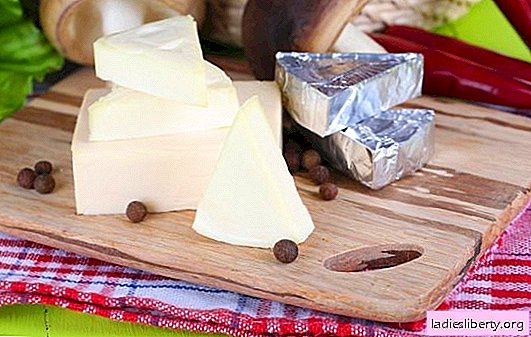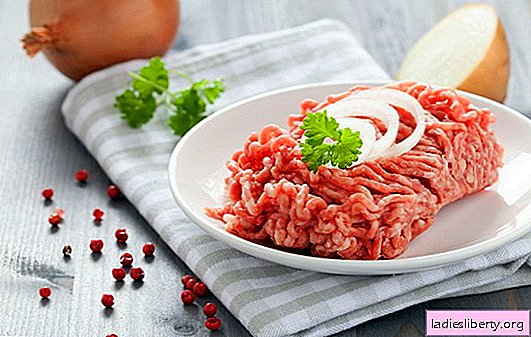
Processed cheeses are distinguished by their special taste and excellent nutritional qualities.
Viscous, like thick sour cream and hard, like regular cheese, they captivate with shades of creamy taste, often embellished with additives from meat, mushrooms, herbs, nuts and sweets.
Cream cheese - benefits, variety and interesting facts
For the manufacture of processed cheeses, rennet hard cheeses of far not the best quality are used - unripe cheese mass, expiring heads, defective cheese - everything goes in one container, along with such dairy products as cottage cheese, milk powder, whey, cream and butter .
An indispensable component of processed cheese is melting salts, which include sodium salts of phosphoric, tartaric and citric acids. Their main function in the recipe is to create a special consistency of the product and prevent the finished cheese from hardening.
The crushed and mixed ingredients, after ripening, are melted into a tasty and best-quality product - processed cheese.
Cream cheese is deliciously smeared on toast or a sandwich, it is added to sauce and mashed soup, pizza and lasagna are cooked with it, pasta, casserole, omelette, pancake filling and stuffing for stuffing quail, eggs and tomatoes, various snacks, salads and even desserts baking, including cookies.
Cream cheese was first made at the beginning of the 20th century in Switzerland, when, according to legend, some cheese-makers needed to somehow save the unrealized remains of the product.
Deciding on a test to melt it, they were pleasantly shocked by the delicious discovery.
The whole variety of processed cheeses can be roughly divided into four varieties.
• Sausage cheese produced mainly from soft and low-fat cheeses. But his consistency is solid, even though in the manner of sausage cut into slices, and in its form, by the way, it is produced. Many sausage cheeses are accompanied by spicy additives, for example, caraway and pepper, smoked shades of taste and aroma;
• Sliced Cheese it tastes like ordinary cheese and is very oily. Often it is produced in the form of ready-to-eat slices, but it is also easy to cut from a single piece;
• Pasty cheese different pronounced cheese flavor and aroma. It goes on sale in plastic containers or in foil wrappers. Its plastic consistency varies from a liquid, resembling a viscous custard, to a density slightly lower than that of a slice cheese. It is pasty cheese that is so wonderful to spread on hot crispy toast;
• Sweet cheeses they may be of any suitable consistency; they are always sweetened with sugar and are usually embellished with nuts, dried fruits, honey, coffee, chocolate, fruit and berry syrups.
With an energy value of 250-300 kcal per 100 g, processed cheese cannot be attributed to dietary products, but on the other hand, it belongs to a very nutritious and easily digestible food, significantly superior to simple rennet cheeses in the latter quality.
In addition, in comparison with them, processed cheese contains almost no carbohydrates and cholesterol.
The fat content of processed cheese is heterogeneous, depending on the varieties - it can reach 25-70%.
One of the main elements of processed cheese, however, like all dairy products in general, is calcium. Only 100 g of processed cheese provide 10-15% of the daily requirement of the body for it.
The benefits of processed cheese and its nutritional value are due to the above characteristics, plus unique balanced complexes of proteins, amino acids, vitamins and trace elements.
It can be called an excellent choice for nutrition during a period of intense physical exertion, for gaining weight and improving health after exhaustion caused by illness or starvation.
In what other cases is the use of processed cheese great
Cream cheese is rich in casein, a high-quality protein that is a source of amino acids that are indispensable for the active activity of the brain and the health of muscle tissue.
The processed cheese is filled with invaluable vitamins A, E, D, PP, H and group B, as well as phosphorus, which is involved in the synthesis of protein in the body.
Vitamin A is especially impeccable digestibility from processed cheese, so you can safely advise yourself to treat them to those who:
• reads a lot and generally cares about his eyesight;
• enriches your diet with products for clean skin with a beautiful even tan.
Which processed cheese can be harmful and who should not eat it
The diet of those who are overweight or dieting so as not to purchase it, does not accept processed cheese in an amount greater than a few plastics as a rare treat. Also, do not get involved in metabolic disorders.
Cream cheese can be harmful in case of upsets and diseases of the stomach with high acidity. The fact is that for its early maturation, citric acid is added to it, and it can irritate mucous surfaces and impede the digestion process.
The high sodium content makes processed cheese undesirable for hypertensive patients and those with cardiovascular diseases.
The salts inevitably present in processed cheese negatively affect the kidneys, slowing the elimination of fluid from the body and, as a whole, when accumulated in it, they can slow down the metabolic processes.
The phosphates included in its composition may also have a bad effect, so again - you should not eat processed cheese for kidney diseases. Further, phosphates neutralize the body’s benefits from phosphorus and calcium and help wash the latter out of the bones, not to mention the fact that with an excess of phosphates in the diet, the skeletal system becomes more fragile.
Finally, processed cheese can be harmful to children of primary school and preschool age, since the abundance of food additives that many manufacturers endow with it can provoke allergic reactions and dermatitis.
How to choose, so as not to buy a tasteless and harmful processed cheese
Some processed cheeses are labeled with GOST, others - TU (specifications) of the manufacturer. It is generally accepted that cheeses are guaranteed to be good in accordance with GOST, due to strict adherence to manufacturing technology, which, ideally, requires the addition of only animal fats (dairy) origin.
If vegetable fats appear in the composition, they can also be palm oil, and this does not add useful properties to cheese. Suspicion should also cause too long, abundant with synthetic additives product composition.
Also, in a good product should be present the main combination that defines its name - "processed cheese", and everything that is not so perfect is called approximately as "processed cheese product".
All cheese should be uniformly colored and have a uniform, homogeneous (excluding the declared filler) consistency.
The quality of processed cheese, the consistency of which allows you to cut it into slices, can be determined by the fact that if it is good, then a slice of it will not crumble and stick to a knife, fingers or teeth.
When choosing processed cheese in a plastic container, it is important to make sure that it has the PP marking on it, indicating that the packaging is made of high-quality polypropylene.
If the plastic is labeled PS, then this is a polystyrene package and it would be wise to refrain from buying cheese. The fact is that more and more product manufacturers are abandoning this material, listening to scientists whose studies talk about the health effects of polystyrene.











